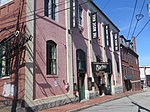South Parish

South Parish is the historic name of a church at 292 State Street in Portsmouth, New Hampshire, in the United States. The church building, built in 1824-26, is one of the earliest examples of Classical Revival architecture in New England, and was listed on the National Register of Historic Places in 1979.Now known as South Church or South Unitarian Universalist Church, the congregation is a covenanting member of the Unitarian Universalist Association, and is an accredited Green Sanctuary. Unitarian Universalism is a liberal religion with Jewish-Christian roots. It has no creed. It affirms the worth of human beings, advocates freedom of belief and the search for advancing truth, and tries to provide a warm, open, supportive community for people who believe that ethical living is the supreme witness of religion. The church is a Welcoming Congregation for bisexual, gay, lesbian, and transgender people.
Excerpt from the Wikipedia article South Parish (License: CC BY-SA 3.0, Authors, Images).South Parish
Court Street, Portsmouth
Geographical coordinates (GPS) Address Nearby Places Show on map
Geographical coordinates (GPS)
| Latitude | Longitude |
|---|---|
| N 43.075555555556 ° | E -70.758055555556 ° |
Address
Court Street
03801 Portsmouth
New Hampshire, United States
Open on Google Maps










